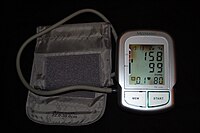
Photo from wikipedia
Study Design This is a prospective study that was undertaken at a single centre and involved 80 consecutive patients diagnosed with lumbar spinal stenosis (LSS). Purpose The aim of the… Click to show full abstract
Study Design This is a prospective study that was undertaken at a single centre and involved 80 consecutive patients diagnosed with lumbar spinal stenosis (LSS). Purpose The aim of the study was to assess the efficacy of a qualitative grading system as seen on magnetic resonance imaging (MRI) as a tool in the management of multilevel LSS. Overview of Literature LSS diagnosis is clinical but is usually radiologically supplemented. However, there are often multilevel radiological findings with non-specific or atypical clinical features. We used a qualitative grading system to help in the decision-making process of the management of patients with multilevel LSS. Methods 80 patients with LSS were treated with decompression and prospectively followed-up for a minimum of 12 months. All had failed conservative treatment. Qualitative grading of LSS severity was based on the dural sac in T2 weighted axial MRI images at all disc levels and was done from L1–2 to L5–S1 (n=400). Functional outcome was assessed using the Oswestry disability index (ODI). Results The mean patient age was 56.6 years, with a gender ratio of 0.6:1. Forty patients had degenerative LSS and 40 had degenerative spondylolysthesis. A total of 178 levels were decompressed, the majority of which were L4–L5 (43.82%), followed by L5–S1 (41.57%). According to our qualitative grading system, grade D stenosis (53.93%) was decompressed most frequently, followed by grade C stenosis (41.57%). The average preoperative ODI score was 58.55%, which later reduced to 19.15%. Seventy percent of patients achieved excellent results, whereas 30% achieved good results. Conclusions Morphological grading is a useful tool in decision making in surgery for multilevel LSS. Grade C and D stenosis should be decompressed, whereas A and B should not be, unless clinically justified.
Journal Title: Asian Spine Journal
Year Published: 2017
Link to full text (if available)
Share on Social Media: Sign Up to like & get
recommendations!